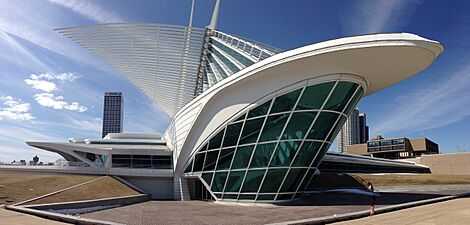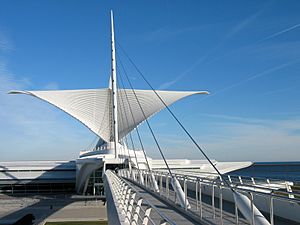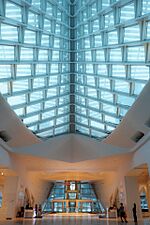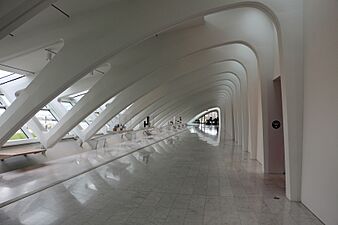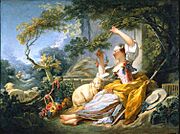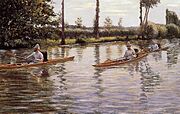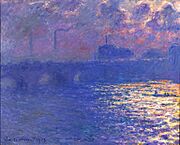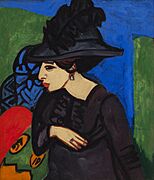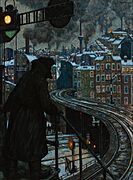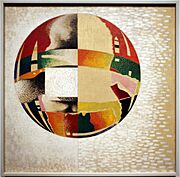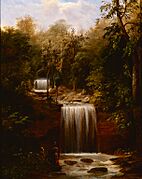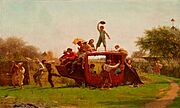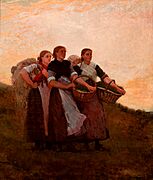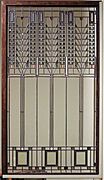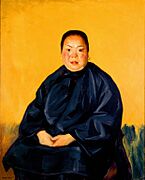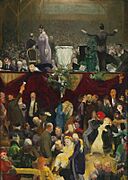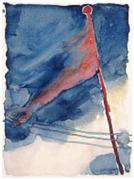Milwaukee Art Museum facts for kids
 |
|
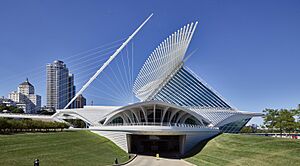
The Museum's Quadracci Pavilion seen from the south
|
|
| Established | 1888 |
|---|---|
| Location | 700 N. Art Museum Drive Milwaukee, Wisconsin |
| Type | Art museum |
| Collection size | 34,000 works |
| Visitors | 232,000 (2023) |
| Public transit access | |
The Milwaukee Art Museum (also called MAM) is a famous art museum in Milwaukee, Wisconsin. It has over 34,000 pieces of art and huge gallery spaces. This makes it the biggest art museum in Wisconsin and one of the largest in the United States.
The museum started when two older art places, the Layton Art Gallery and the Milwaukee Art Institute, joined together. Both of these started in 1888. In 1957, their art collections moved into the new Milwaukee County War Memorial building. This building was designed by a famous architect named Eero Saarinen. The museum was first called the Milwaukee Arts Center, but its name changed to Milwaukee Art Museum in 1980. Later, new parts were added, like the David Kahler Building in 1975 and the amazing Quadracci Pavilion in 2001. The Quadracci Pavilion was designed by Spanish architect Santiago Calatrava. An East End entrance was also opened in 2015.
The museum's art collection includes many cool things. You can see paintings by American artists from the Ashcan School, beautiful decorative arts from America and Europe, and German art from the 1800s and early 1900s. There's also German Expressionist art, folk art, and Haitian art. The museum also has one of the biggest collections of art by Wisconsin-born artist Georgia O'Keeffe in the United States.
In 2024, the Milwaukee Art Museum was voted the 8th best art museum in the country by readers and editors of USA Today. This is one of the biggest newspapers in the US.
Contents
Visiting the Museum
The Milwaukee Art Museum is located right on the shore of Lake Michigan. It is one of the largest art museums in the Midwestern United States. Besides its many art galleries, the museum also has a cafe called Cafe Calatrava and a gift shop where you can find unique items.
Museum Hours
The museum is open Wednesday, Friday, Saturday, and Sunday from 10:00 a.m. to 5:00 p.m. On Thursdays, it stays open later, from 10:00 a.m. to 8:00 p.m. The museum is closed on Mondays and Tuesdays.
Museum History
How It Started: Before the 1960s
Around 1870, people in Milwaukee wanted to have an art gallery. At that time, Milwaukee was a growing port city, but it didn't have good places to show big art exhibits. Even though there were art collectors in town, like banker Alexander Mitchell, and manufacturers William Henry Metcalf and Charles Allis, it was hard to build a major art gallery.
In 1883, a local businessman named Frederick Layton suggested building an art gallery for Milwaukee. He was an immigrant from Britain who became rich from selling meat and building railroads in Wisconsin. He hired a Scottish architect, George Ashdown Audsley, to design the building. This building later became known as the Layton Art Gallery. It was a one-story building with a Greek Revival style, and it opened on April 5, 1888. Layton gave $100,000 to the new gallery to buy artworks, and some of his own art was also shown there.
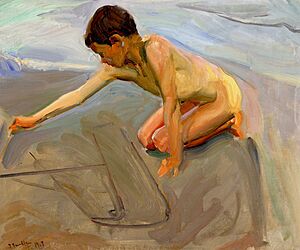
At the same time, another group of German artists and local business people started the Milwaukee Art Association in 1888. They also wanted to be the city's first art gallery. In 1911, this group moved into a new building next to the Layton Art Gallery. Five years later, they changed their name to the Milwaukee Art Institute. The institute's collection grew mostly from gifts and art bought from Wisconsin artists.
After Frederick Layton passed away, Charlotte Partridge, an educator, became the curator and director of the Layton Art Gallery in 1922. She had started the Layton School of Art two years before. During her time, she focused on showing and buying modern art. She also helped lead the Federal Art Project for Wisconsin from 1935 to 1939, which was part of a government program called the Works Progress Administration. Meanwhile, a German-born painter named Alfred Pelikan became the director of the Milwaukee Art Institute in 1926 and stayed in that job until 1942.
In 1954, Charlotte Partridge retired from the Layton Art Gallery. A year later, the Milwaukee Art Institute and Layton Art Gallery joined together to form the Milwaukee Art Center. This new institution moved into the recently built Eero Saarinen-designed Milwaukee County War Memorial building and officially opened in 1957.
The Kahler Building and Growing Collections
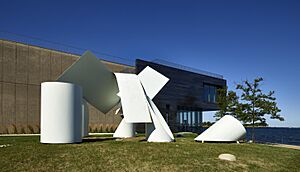
In 1975, Margaret (Peg) Bradley gave more than 600 pieces of Modern art from Europe and America to the museum. This amazing gift included Fauvist paintings, German Expressionist works by artists like Wassily Kandinsky and Ernst Ludwig Kirchner, and several works by Georgia O’Keeffe. To hold all this new art, a new building called the Kahler Building was designed by architect David Kahler. This building, which opened in 1975, has a brutalist style. Peg Bradley herself gave $1 million to help build this new part. After the Kahler expansion, the institution officially changed its name to the Milwaukee Art Museum in 1980.
In 1989, the museum's collection of folk and self-taught art grew much stronger with a gift from Michael and Julie Hall. In 1999, the Chipstone Foundation from Milwaukee started working with the museum. They began showing parts of their collections of American decorative arts and furniture in special galleries.
The Quadracci Pavilion and More Expansions (Since 2001)
The Quadracci Pavilion is a large, multi-purpose building designed by Spanish architect Santiago Calatrava. It was finished in 2001. This building includes a big reception hall, an auditorium, exhibition spaces, and a store. The way it was built, using concrete slabs with timber frames, was very new for architecture. At the center of the building is Windover Hall, a grand reception area 90 feet tall with a glass roof. The building's design looks like a ship sailing on Lake Michigan. Calatrava said the building's shape helps complete the museum, controls light, welcomes visitors, and creates a memorable image for the museum and the city.
The Quadracci Pavilion has a special movable roof called a brise soleil. It opens up like wings, stretching 217 feet wide during the day, and folds up at night or when the weather is bad. Sensors on the wings check wind speeds. If winds are stronger than 23 miles per hour for at least three seconds, the wings close for safety. In 2004, the pavilion won the Outstanding Structure Award from a group called the International Association for Bridge and Structural Engineering. With this addition, the museum grew to a total size of 341,000 square feet.
-
Reiman Pedestrian Bridge and open Burke brise soleil
The Cudahy Gardens were designed along with the Quadracci Pavilion by landscape architect Dan Kiley. This garden is 600 feet long and 100 feet wide. It is divided into five grassy areas by tall hedges. In the center of the garden, there is a fountain that creates a 4-foot-tall water curtain. You can also see linden trees and crabapple trees throughout the garden. The gardens were named after Michael Cudahy, who gave a lot of money to help build them.
In 2001, the Herzfeld Photography, Print, and Drawing Study Center opened in the Kahler Building. This happened because of a gift from the Richard and Ethel Herzfeld Foundation. In 2004, the museum received nearly 300 American and European artworks from the collection of Maurice and Esther Leah Ritz. Later, in 2010 and 2012, the museum gained almost 500 folk and self-taught American artworks. These came from the collections of businessman Anthony Petullo and playwright Lanford Wilson. This included paintings and sculptures by African American artists like Bill Traylor, Clementine Hunter, William L. Hawkins, Joseph Yoakum, Minnie Evans, and Bessie Harvey.
In November 2015, the museum opened a $34 million expansion. This project was paid for by the museum and Milwaukee County. The expansion was designed by Milwaukee architect James Shields and the HGA firm. It added more gallery space, including a section for light-based art, photography, and video installations. The new two-story building is 120,000 square feet and includes a new entrance facing the lake.
In 2017, the museum brought together its George Peckham Miller Art Research Library (which started in 1916), its archives, and its old papers into one place called the Milwaukee Art Museum Research Center. Some of these collections were moved to the historic Judge Jason Downer Mansion, in the Yankee Hill neighborhood. This house was built in 1874 for a lawyer and former judge, Jason Downer. It is a High Victorian Gothic style house. The house was added to the National Register of Historic Places in 1989. The museum's archives also keep papers and drawings from famous designers like Brooks Stevens and George Mann Niedecken.
In December 2017, the museum announced it bought O'Donnell Park, which is nearby, from Milwaukee County. The museum had already put a public sculpture called The Calling by American artist Mark di Suvero in the park in 1982. In 2023, the park was officially renamed Museum Center Park.
Art Collection Highlights
The museum has over 34,000 pieces of art. A special selection of these works is shown on four floors, covering art from ancient times to today. The collection includes European art from the 1400s to the 1900s, and American art from the 1600s to the 1900s. You can see paintings, sculptures, prints, drawings, decorative arts, photographs, and folk and self-taught art.
Some of the famous artists whose works are in the collection include Gustave Caillebotte, Francisco de Zurbarán, Jean-Honoré Fragonard, Auguste Rodin, Edgar Degas, Claude Monet, Gabriele Münter, Henri de Toulouse-Lautrec, Frank Lloyd Wright, Pablo Picasso, Joan Miró, Wassily Kandinsky, Mark Rothko, Robert Gober, and Andy Warhol.
You can also find paintings by European artists like Francesco Botticini, Jan Swart van Groningen, Jan van Goyen, Franz von Lenbach, Ferdinand Waldmüller, Carl Spitzweg, William-Adolphe Bouguereau, Jean-Léon Gérôme, Gustave Caillebotte, Camille Pissarro, Jules Bastien-Lepage, and Max Pechstein.
Art Galleries
European Art
-
A Rus Kolty Pendant, 12th Century
-
Francisco de Zurbarán, Saint Francis of Assisi in His Tomb, 1630-34
-
Jean-Honoré Fragonard, The Shepherdess, 1750-52
-
Gustave Caillebotte, Boating on the Yerres, 1877
-
Jules Bastien-Lepage, Le Père Jacques (The Wood Gatherer), 1881
-
Jean-Léon Gérôme, The Two Majesties (Les Deux Majestés), 1883
-
Claude Monet, Waterloo Bridge, c. 1900 (dated 1903)
-
Ernst Ludwig Kirchner, Dodo with a Feather Hat (Dodo mit Federhut), 1911
-
László Moholy-Nagy, Nuclear II, 1946
American Art
-
Robert S. Duncanson, Minneopa Falls, 1862
-
Eastman Johnson, The Old Stagecoach, 1871
-
Frank Lloyd Wright, Tree of Life window, from the Darwin D. Martin House, in Buffalo, New York, 1904
-
Robert Henri, Chinese Lady, 1914
-
George Bellows, The Sawdust Trail, 1916
-
Georgia O'Keeffe, The Flag, 1918
-
Standing Woman by Gaston Lachaise (50527418523).jpg
Gaston Lachaise, Standing Woman, 1932 (cast 1980)
-
Lois Mailou Jones, The Ascent of Ethiopia, 1932
-
Andy Warhol, Campbell's Soup Cans, 1965
Museum Leadership
Directors of the Museum
Layton Art Gallery Directors (1888–1955)
- 1888–1919: Frederick Layton (as president)
- 1919–1922: James K. Ilsley (as president)
- 1922–1954: Charlotte Partridge
- 1954–1955: Edmund Lewandowski
Milwaukee Art Institute Directors (1888–1955)
- 1888–1901: Christian Wahl (as president)
- 1910–1911: Charles Allis (as president)
- 1911–1913: Samuel O. Buckner (as president)
- 1913–1924: Dudley Crafts Watson
- 1924–1926: John Ellingwood Donnell Trask
- 1926–1942: Alfred Pelikan
- 1942–1951: George Burton Cumming
- 1951–1955: La Vera Pohl
Milwaukee Art Museum Directors (since 1955)
- 1955–1962: Edward H. Dwight
- 1962–1977: Charles Tracy Atkinson
- 1977–1985: Gerald Nordland
- 1985–2002: Russell Bowman
- 2002–2008: David Gordon
- 2008–2016: Daniel Keegan
- 2016–2025: Marcelle Polednik
How the Museum is Funded
As of 2015, the museum had about $65 million saved up. This money helps pay for some of the museum's costs, but it also relies on money from daily things like ticket sales. Daniel Keegan, who was the museum's director from 2008 to 2016, worked out a deal in 2013 with Milwaukee County to help manage and fund the museum's buildings for a long time. In 2024, a gift of $3.54 million helped create a special fund. This fund makes it possible for children aged 12 and under to visit the museum for free.
See also
 In Spanish: Museo de Arte de Milwaukee para niños
In Spanish: Museo de Arte de Milwaukee para niños
- List of largest art museums
- List of museums in Wisconsin
- Layton Art Gallery
- List of public art in Milwaukee, including sculpture belonging to the museum's collections




